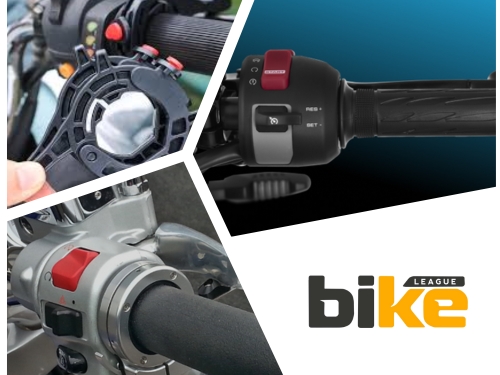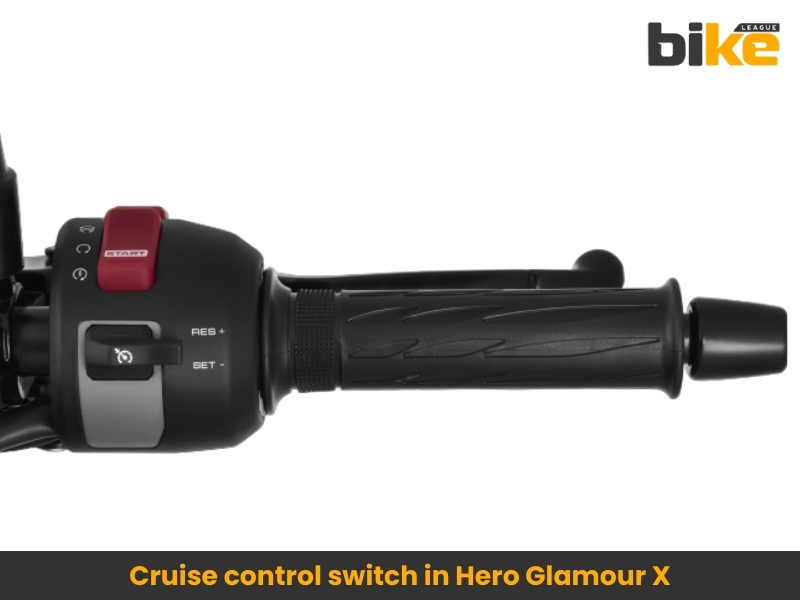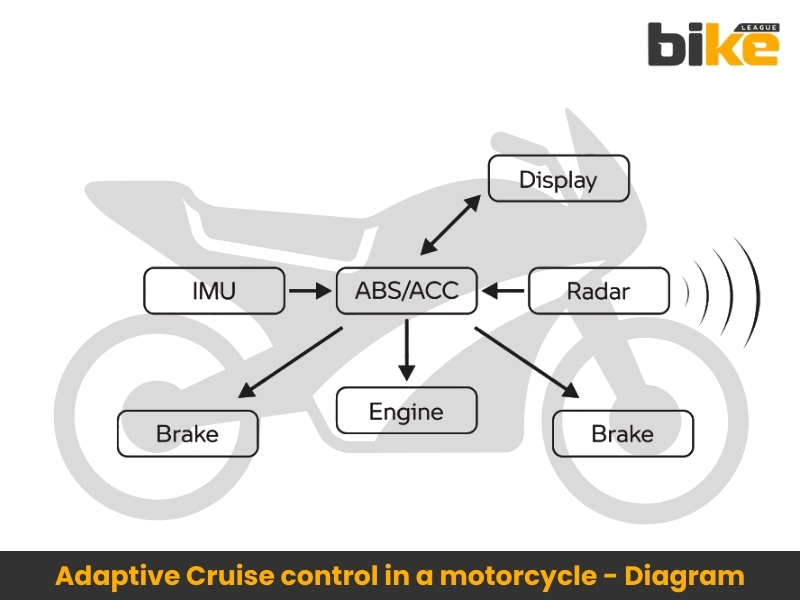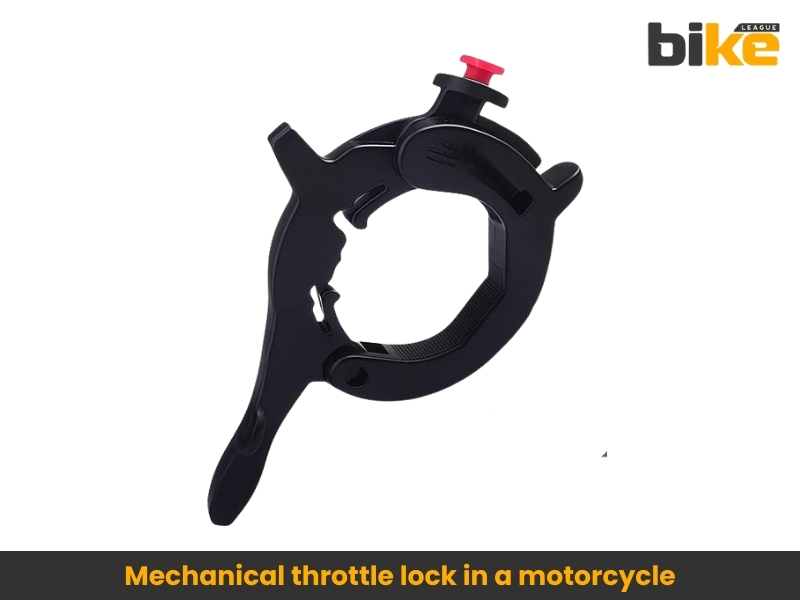
Long story short: Long motorcycle journeys can be tough—discover how cruise control transforms comfort, safety, and endurance for riders.
Cruise control is now available on many motorcycles in India, enhancing the comfort of long rides. Previously, it was only available on premium models. The addition of cruise control to the first 125cc motorcycle has made some people question whether the feature is essential. Ready to discover if cruise control is proper for you? Let’s look at how it works, which bikes have it, what you should consider, and its real pros and cons.
Key Takeaways
- Cruise control is an electronic system that lets riders keep a steady speed without having to hold the throttle all the time.
- To cruise control, you reach your desired motorcycle speed and press the cruise control button on the handlebars.
- Adaptive Cruise Control (ACC) is a system that automatically changes the bike’s speed to keep a safe distance from vehicles ahead.
- Unlike electronic cruise control, mechanical throttle locks require manual adjustments, but they can be overridden instantly for safety.
What is Cruise Control in Motorcycles?
Cruise control allows riders to maintain a steady speed without constantly holding the throttle. This is especially helpful on long highway rides, as it reduces fatigue and ensures a consistent speed.
What are the different types of motorcycle cruise control?
- Standard Electronic Cruise Control
- Adaptive (Radar-Based) Cruise Control
- Mechanical Throttle Locks
Now, let’s look more closely at the different types of motorcycle cruise control.
1. Standard Electronic Cruise Control

How Standard Electronic Cruise Control Works
Motorcycle cruise control connects to the speedometer, fuel injection, and throttle. Reach your chosen speed, press the button, and the system maintains that speed—no constant throttle needed.
If you use the brakes or pull the clutch, the cruise control will automatically turn off for safety. You can also adjust your speed with the control buttons or turn off the system by twisting the throttle or using the brakes.
List of some motorcycle models in India Featuring Standard Electronic Cruise Control
- KTM Duke 390
- KTM 390 Adventure
- Suzuki Hayabusa
- Kawasaki Ninja ZX-10R
- Harley-Davidson Pan America 1250
- Triumph Tiger 850 Sport
- Ola Electric S1 Pro
- Odysse Electric Hawk Plus
- OLA Roadster
- Kawasaki Z900
- Kabira Mobility KM3000
Pros of Standard Electronic Cruise Control
- Reduced Rider Fatigue: No need to constantly operate the throttle, leading to less strain during long rides.
- Improved Fuel Efficiency: Maintaining constant speed helps optimise engine performance. It can boost mileage, especially over highway journeys.
- Speed Regulation: Helps prevent speeding, especially in zones with strict enforcement.
- Convenience for Touring: Makes long-distance travel less tiring and more enjoyable, especially on open highways.
Cons of Standard Electronic Cruise Control
- Limited Use in Urban Traffic: Cruise control is most effective on open highways, as frequent stops and unpredictable traffic in cities make it unsuitable for regular urban use.
- Potential Drowsiness: Maintaining a steady speed for long periods can reduce rider alertness.
- Reaction Time: Leg relaxation may increase the time taken to react in emergencies.
- Expense & Complexity: Still limited mainly to mid- and high-end motorcycles; aftermarket options are costly and complex to install/repair.
- Maintenance Concerns: More electronics mean more points of failure; repairs can be expensive and complex compared to throttle locks or manual systems.
Step-by-step flow of cruise control working on motorcycles
- The rider accelerates to the target speed and presses the ‘SET’ button.
- The ECU stores the desired speed.
- The throttle actuator maintains this set speed by monitoring and adjusting the throttle position.
- Pressing the brakes or clutch, or manually turning OFF the system, immediately disengages cruise control as a safety measure.
- The RESUME/ACCEL/DECEL buttons enable incremental speed changes without requiring manual throttle input.
2. Adaptive cruise control
Adaptive Cruise Control (ACC) is a system that automatically changes the bike’s speed to keep a safe distance from vehicles ahead. Unlike regular cruise control, which maintains a set speed, ACC utilises radar sensors to monitor traffic and can adjust the throttle or apply the brakes as needed.
ACC is mainly found in high-end touring and adventure motorcycles with electronic throttle control, representing one of the closest options to semi-autonomous riding for two-wheelers.
How does Adaptive Cruise Control work?
Some high-end motorcycles feature adaptive cruise control (ACC), which adds a radar sensor to monitor traffic ahead. ACC automatically adjusts speed to maintain a safe following distance from vehicles in front.
If another vehicle slows down, the system reduces the throttle or applies the brakes to keep a distance, then accelerates back to the pre-set speed when the road clears.
List of some models in India having Adaptive Cruise Control
Here is a list of motorcycles available in India that feature Adaptive Cruise Control (ACC):
- KTM 1290 Super Adventure S / EVO
- Kawasaki Ninja H2 SX SE
- BMW R 1250 RT
- BMW R 18 Transcontinental / Bagger
- Ducati Multistrada V4
- Honda Gold Wing
- Harley Davidson Sportster S
Pros of Adaptive Cruise Control
- Reduces rider fatigue: ACC minimises the need for constant throttle, brake, and clutch adjustments on long highway rides, making touring much more comfortable.
- Improves safety: By automatically maintaining distance from vehicles ahead and sometimes assisting with braking, ACC helps avoid rear-end collisions and promotes safer group or urban riding.
- Smoother ride: Consistent speed and smooth automatic adjustments reduce abrupt acceleration or braking, leading to a more relaxed and controlled experience.
- Advanced features: Modern ACC systems may support group ride modes, collision warnings, brake assist, and multi-level distance settings.
- Promotes fuel efficiency: Maintaining a steady speed and avoiding sudden accelerations can improve fuel economy during long journeys.
Cons of Adaptive Cruise Control
- Higher cost: Motorcycles with ACC are significantly more expensive due to added sensors, specialised software, and integration requirements.
- Complexity and maintenance: ACC systems require calibration, sensor care, and can be costly to repair if damaged.
- Unpredictable road challenges: On chaotic or unpredictable roads, ACC may struggle with erratic traffic, sudden lane changes, and significant obstacles, demanding rider vigilance and manual intervention.
- Potential overreliance: Riders might become complacent or rely too heavily on the system, slowing reaction times during sudden incidents.
- Compatibility issues: Aftermarket installation is rarely feasible; ACC is generally available only in select new, high-end models, limiting widespread adoption and upgrade possibilities.
- Weather and visibility limits: Radar and camera-based systems can be less effective in heavy rain, fog, or dust.
Adaptive vs Standard Cruise Control in motorcycles
The table below shows the difference between adaptive and standard cruise control on a motorcycle.
| Feature | Standard Cruise Control | Adaptive Cruise Control (ACC) |
|---|---|---|
| Functionality | Maintains a fixed speed set by the rider | Automatically adjusts speed to maintain safe distance from vehicles ahead |
| Speed Adjustment | Rider adjusts speed manually | System automatically accelerates or decelerates based on traffic conditions |
| Traffic Interaction | Does not respond to slower traffic or obstacles | Detects and reacts to other vehicles with radar or sensors |
| Brake Control | No automatic braking | Can apply brakes automatically to maintain safe following distance |
| Throttle Control | Maintains throttle position electronically | Controls throttle and sometimes brakes for smooth speed control |
| Safety | Disengages when brakes or clutch are applied | Adds collision warning, safe distance keeping, and adaptive speed changes |
| Use Cases | Suitable for long, open highway stretches with steady traffic | Best for varying traffic and dynamic road conditions, including stop-and-go traffic |
| Technology Complexity | Simple system with throttle control | Complex system with radar, sensors, electronic control unit, and braking integration |
| Rider Convenience | Reduces fatigue by eliminating constant throttle operation | Enhances safety and convenience by handling distance and speed dynamically |
| Cost and Availability | Common in mid to high-end motorcycles | Mostly available in premium adventure and touring motorcycles |
3. Mechanical Throttle Locks
Mechanical throttle locks create friction on the throttle sleeve under the grip, keeping the engine speed steady at the rider’s selected position. Devices like the Kaoko and ATLAS Throttle Lock are mounted at the grip end and can be quickly engaged or disengaged using your thumb or palm. Unlike electronic cruise control, these locks require manual adjustments; however, they can be overridden instantly for safety purposes.
Pros of Mechanical Throttle Locks
- Reduces wrist fatigue: Great relief on long rides—no need to grip the throttle constantly.
- Affordable and universal: Easy to install, fits nearly any motorcycle, no electrical modification required.
- Quick installation/removal: Most take 5–10 minutes to install and can be transferred between bikes.
- Doesn’t interfere with electronics: Can be used alongside electronic cruise control or heated grips.
- Instant override: Friction-based locks can be disengaged quickly by rolling off the throttle for emergency braking.
Cons of Mechanical Throttle Locks
- No automatic speed adjustment: Unlike adaptive electronic systems, mechanical locks don’t react to changes in terrain, incline, or traffic—manual input is needed.
- Potential safety risks: If a rider forgets the lock is engaged, reaction time may be reduced in emergencies.
- Grip ergonomics: Some locks can make grips or handlebars feel cramped, especially rubber sleeve styles.
- Less precise for fine adjustment: Finding the optimal friction and position for steady cruising can take practice, and cheaper models may loosen with vibration or over time.
- Not true cruise control: The device holds throttle position, so speed can vary with wind, hills, or load changes.
What are the specific safety features of cruise control systems in motorcycles?
- Automatic Disengagement: Engaging the clutch or brakes instantly turns off the cruise control, giving the rider complete control when necessary.
- Electronic Fault Monitoring: Most systems monitor for throttle, sensor, and brake malfunctions, disabling cruise if any abnormality is detected.
- Speed Limit & Gear Restrictions: Many systems only engage at speeds above 32 km/h and in higher gears, preventing activation in low-speed, high-traffic situations.
- Manual Cancel Controls: Riders can easily deactivate cruise with a dedicated switch or throttle override.
- Adaptive Cruise Control (ACC): Premium models feature radar-based ACC, which automatically adjusts speed to maintain a safe following distance and sometimes even modulates speed in curves for improved stability.
- Throttle-by-Wire Presets: Modern systems offer precise electronic throttle control, reducing the risk of accidental acceleration or system “runaway”.
How does cruise control affect the overall riding experience in varied weather conditions in India?
1. Monsoon & Rainy Conditions
- Reduced Traction: Cruise control should not be used on wet or slippery surfaces. It can delay the rider’s response time to unexpected hydroplaning or sudden loss of grip, increasing accident risk.
- Hydroplaning Danger: If the motorcycle begins to hydroplane while cruise is engaged, the system may not reduce speed as quickly as required, leading to loss of control.
- Recommendation: Riders should turn off cruise control in the rain or on waterlogged roads to maintain manual speed management and responsiveness.
2. Hot Summers
- Tyre & Engine Stress: Consistent high-speed cruising can further heat tires and engines, so regular checks for tire pressure, coolant, and engine temperature are crucial.
- Fatigue Reduction: Cruise control offers a significant comfort advantage on long, hot highway stretches by helping prevent fatigue from holding the throttle for hours.
3. Fog, Dust, and Winter
- Limited Visibility:In fog and low-visibility scenarios, quick speed adjustments are often required. Cruise control could delay these reactions, making manual operation safer.
- Curve and Corner Response: Adaptive systems (with curve control) help by adjusting speed based on lean angle or curves, but for standard cruise, disengagement before curves is widely recommended.
What are the best practices for riders while using cruise control on bikes?
Here are a few tips riders should consider while using cruise control.
- Avoid Over-Reliance: Cruise control, especially on long, straight highways, can lead to reduced stimulation and increased drowsiness or inattentiveness; studies indicate longer reaction times when relying solely on cruise control.
- Take Regular Breaks: Stop every hour or so to stretch, hydrate, and refocus—this is vital for managing both mental and physical fatigue.
- Change Riding Routine: Vary your speed (where safe and legal), adjust your position, and periodically turn cruise control off to stay engaged.
- Stay Hydrated and Fed: Dehydration and low blood sugar can seriously impact alertness; drink water and snack as needed.
- Use Music or Audio Cues: Stimulate your senses with safe music or audio (not noise-cancelling earbuds), but don’t drown out essential road sounds.
- Mental Engagement: Practice visualisation, scan for hazards, and anticipate traffic changes instead of zoning out.
- Riding with a group: Group riding makes the journey more engaging, helps maintain alertness, and provides regular stop cues.
FAQ about Cruise Control on motorcycles
1. Which motorcycles in India have cruise control as standard?
Popular models include the Hero Glamour X, KTM 390 Adventure, TVS Apache RTR 310, OLA Roadster, Suzuki Hayabusa, and Kawasaki Ninja ZX-10R.
2. What are the benefits of cruise control for Indian riders?
It reduces wrist fatigue, enhances riding comfort on long trips, helps in maintaining legal speed limits, and improves fuel efficiency for highway travel.
3. Is cruise control available on budget or commuter motorcycles?
Yes, with recent launches like the Hero Glamour X (in the 125cc segment) and the OLA Roadster, cruise control is now available on entry-level bikes.
4. Are adaptive or radar-based cruise control systems available in India?
Adaptive cruise control is currently limited to premium bikes, such as some Ducati and BMW models. It is not commonly found on mass-market motorcycles in India.
5. How is cruise control activated or deactivated on motorcycles?
To activate cruise control, use the handlebar switch after reaching your desired speed. It will turn off right away if you use the brakes, clutch, or throttle.
6. Can cruise control be installed as an aftermarket feature on any bike?
You can add basic cruise control with mechanical throttle locks or universal kits. However, electronic cruise control usually comes built-in on certain motorcycles.
7. What are the safety risks or considerations of using cruise control?
Riders should always stay alert because cruise control cannot react to sudden changes in traffic. It is important to turn it off quickly during emergencies to stay safe.
8. Does cruise control work on city streets or only on highways?
Cruise control works best on highways. In city traffic, where you often need to stop or change speed, it is not as helpful.
Other related articles from Bikeleague India
- What all basic motorcycle accessories should a rider have
- Braking in motorcycle – All expert tips for bikers
- Indian Roadmaster
- Bajaj Avenger Cruise 220
- Ducati Scrambler 2G Full Throttle
Conclusion
Cruise control is making motorcycle rides in India easier and more comfortable than ever. Are you thinking about adding it to your ride? Consider the pros, cons, and your own style to decide if it’s right for your adventures!. Suppose you have more questions about motorcycle cruise control. In that case, you can email us at bikeleague2017@gmail.com, leave a comment, or contact us on Bikeleague India’s social media. We’re happy to help.



